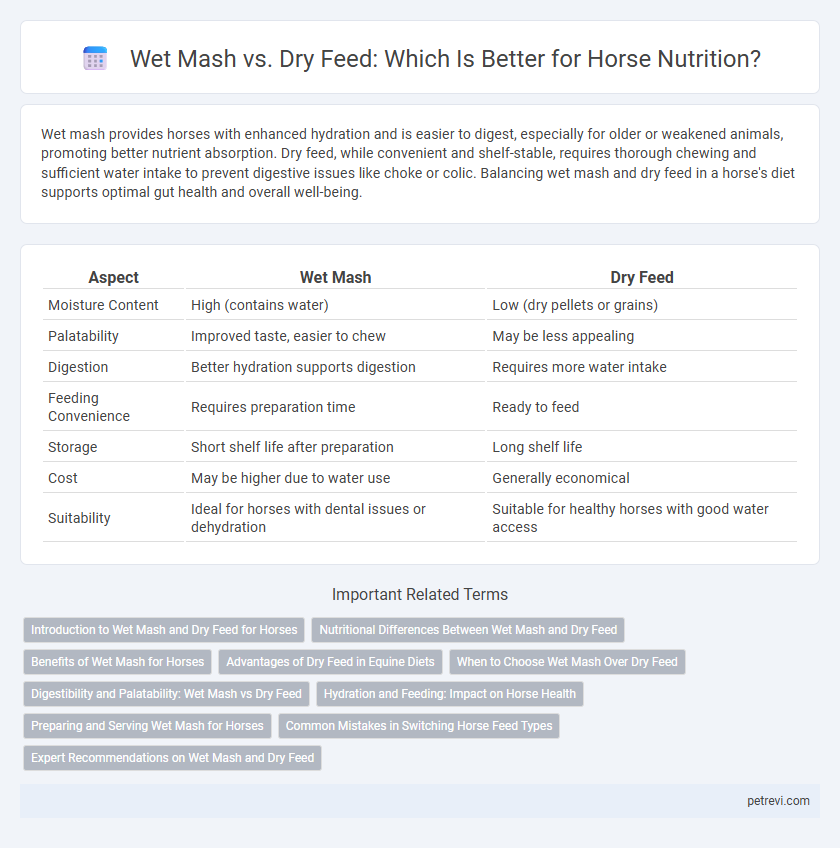Wet mash provides horses with enhanced hydration and is easier to digest, especially for older or weakened animals, promoting better nutrient absorption. Dry feed, while convenient and shelf-stable, requires thorough chewing and sufficient water intake to prevent digestive issues like choke or colic. Balancing wet mash and dry feed in a horse's diet supports optimal gut health and overall well-being.
Table of Comparison
| Aspect | Wet Mash | Dry Feed |
|---|---|---|
| Moisture Content | High (contains water) | Low (dry pellets or grains) |
| Palatability | Improved taste, easier to chew | May be less appealing |
| Digestion | Better hydration supports digestion | Requires more water intake |
| Feeding Convenience | Requires preparation time | Ready to feed |
| Storage | Short shelf life after preparation | Long shelf life |
| Cost | May be higher due to water use | Generally economical |
| Suitability | Ideal for horses with dental issues or dehydration | Suitable for healthy horses with good water access |
Introduction to Wet Mash and Dry Feed for Horses
Wet mash feeding involves soaking or steaming grains and supplements, making digestion easier and improving nutrient absorption in horses. Dry feed, typically composed of pellets or unprocessed grains, requires more saliva for digestion but offers convenience and longer shelf life. Choosing between wet mash and dry feed depends on individual horse digestive health, feeding goals, and management practices.
Nutritional Differences Between Wet Mash and Dry Feed
Wet mash offers higher moisture content, improving hydration and aiding digestion through softer fiber breakdown compared to dry feed. Dry feed retains more concentrated nutrients, such as carbohydrates and proteins, but may require increased water intake to prevent dehydration. Nutrient bioavailability varies between feeds, with wet mash enhancing mineral absorption while dry feed supports longer storage stability and vitamin retention.
Benefits of Wet Mash for Horses
Wet mash feeding enhances hydration and improves nutrient absorption in horses, supporting optimal digestive health. The moisture content in wet mash aids in preventing colic and promoting saliva production, which is essential for proper digestion. This type of feed also helps in reducing feed waste and allows easier consumption for horses with dental issues.
Advantages of Dry Feed in Equine Diets
Dry feed offers superior convenience and longer shelf life compared to wet mash, reducing spoilage risks in equine diets. It ensures consistent nutrient delivery with balanced fiber and energy levels tailored to horse needs. Additionally, dry feed promotes dental health by encouraging chewing and saliva production, crucial for proper digestion in horses.
When to Choose Wet Mash Over Dry Feed
Wet mash is ideal for horses experiencing dental issues, as the softened texture eases chewing and digestion. It is also beneficial for dehydrated horses, promoting fluid intake and improving nutrient absorption. Selecting wet mash over dry feed supports digestive health in horses with sensitive stomachs or those recovering from illness.
Digestibility and Palatability: Wet Mash vs Dry Feed
Wet mash feed for horses enhances digestibility by facilitating easier nutrient breakdown and absorption due to higher moisture content, which promotes better enzyme activity and gut motility. Palatability improves as the soft texture and aroma of wet mash stimulate appetite compared to dry feed, which horses may find less appealing and harder to chew, potentially leading to slower intake. Optimal feeding practices consider wet mash to support horses with dental issues or picky eaters, ensuring efficient nutrient utilization and overall digestive health.
Hydration and Feeding: Impact on Horse Health
Wet mash feed significantly improves hydration levels in horses by providing additional moisture, which supports digestive health and prevents colic. Dry feed, while convenient, often requires increased water intake to compensate for lower moisture content, potentially leading to dehydration if water access is limited. Optimal feeding practices balance dry feed with ample water or incorporate wet mash to enhance nutrient absorption and maintain equine gut function.
Preparing and Serving Wet Mash for Horses
Preparing wet mash for horses involves soaking grains and bran in water or molasses to create a palatable, easily digestible feed that encourages hydration and nutrient absorption. Wet mash should be mixed thoroughly and served fresh to prevent spoilage and maintain its nutritional value, with feeding quantities tailored to the horse's size, workload, and dietary needs. Using warm water during preparation can enhance flavor and intake, while monitoring for leftover mash helps avoid bacterial growth and digestive issues.
Common Mistakes in Switching Horse Feed Types
Switching between wet mash and dry feed without a gradual transition often causes digestive upset in horses due to abrupt changes in fiber and moisture content. Failing to monitor feed intake and hydration levels can lead to colic or dehydration, as horses respond differently to moisture-rich wet mashes and concentrated dry feeds. Neglecting to adjust feed quantity and nutrient balance during the switch may result in nutritional deficiencies or weight fluctuations, impacting overall equine health and performance.
Expert Recommendations on Wet Mash and Dry Feed
Expert recommendations on horse feeding emphasize that wet mash promotes better hydration and aids digestion by softening fibrous feed components. Dry feed offers convenience and long shelf life but requires consistent water access to prevent colic risks. Balancing wet mash and dry feed intake tailored to the horse's health status and activity level optimizes nutrient absorption and overall equine wellness.
Wet Mash vs Dry Feed for Horse Feeding Infographic

 petrevi.com
petrevi.com